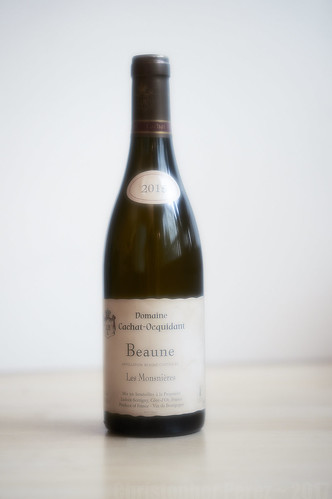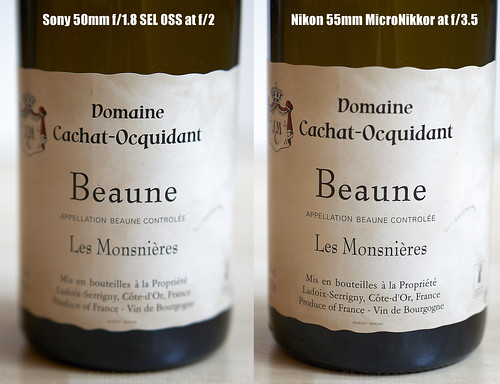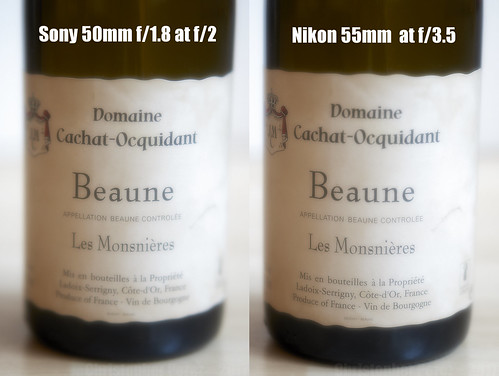I think I like the Nikon Soft filter number one. The effect seems to achieve the right balance between softness and sharpness. After realizing this I wanted to see what effect aperture setting had when combined with the filter.
Dinner one night called for a new (to us) kind of bird and a new (to us) vineyard's wine. Before opening the bottle I took out a couple lenses snapped a few images. Here was the setup:
Here is the very same scene shot with the Soft filter. I snugged up the highlights and shadows to match the scene contrast of the images made without the filter. The Soft filter flattens the image contrast pretty dramatically. In the future, when using the Soft filter I will try to remember to overexpose the scene and to do so without clipping the highlights.
As you can see, the Soft filter really does the trick it's supposed to do. There is the softness it's famous for, but there's also something else. Looking at the light to dark transitions (such as in the lettering) the Soft filter retains a surprising amount of "sharpness." The effect is nothing like one gets with a nylon stocking over the front of a lens, nor is it anything like a shot made with petroleum jelly over a UV filter on the front of an optic.
Looking specifically at the Sony and Nikkor images shot with the Soft filter, you can see the edges of the bottle from the Sony 50mm falls off into a blur more quickly than the Nikon 55mm. This should be expected as the Sony lens was shot at f/2 and the Nikkor was set to f/3.5.
The Nikon Soft filter seems to provide an interesting tradeoff between sharp and soft. It could be interesting to use when deliberately attempting to recreate a late-1800's Pictorialist style. I feel yet another project coming on.
Dinner one night called for a new (to us) kind of bird and a new (to us) vineyard's wine. Before opening the bottle I took out a couple lenses snapped a few images. Here was the setup:
- Sony NEX-5T
- Sony 50mm SEL OSS f/1.8 at f/2
- Nikon Micro-Nikkor 55mm f/3.5 at f/3.5
- Tabletop tripod - to get as low as possible
- Bottle of white wine (cepage chardonnay) from Beaune
Here is the test subject, which, by the way, is quite good.
Jacky (a good friend of our's) and I found this vineyard after tromping the aisles of les vignerons independent and sampling only white Burgundian wines. If you know white wine, you know of Meursault, Chassagne-Montrachet, and Pouilly-Fuissé. At the salon we sampled everything we could, including wines from bottles costing well north of 50Euro. Nothing came close to this little no-nothing-name vinters products. Follow this advice with caution since I'm a beer drinker and really can't be trusted on things wine.
Oh. Yes. This image was made using the Sony 50mm f/1.8 SEL OSS at f2 (I must've hit the dial by accident as I wanted this shot at f/1.8 - by the time I found the error my wife and I were well into the contents of the bottle).
Jacky (a good friend of our's) and I found this vineyard after tromping the aisles of les vignerons independent and sampling only white Burgundian wines. If you know white wine, you know of Meursault, Chassagne-Montrachet, and Pouilly-Fuissé. At the salon we sampled everything we could, including wines from bottles costing well north of 50Euro. Nothing came close to this little no-nothing-name vinters products. Follow this advice with caution since I'm a beer drinker and really can't be trusted on things wine.
Oh. Yes. This image was made using the Sony 50mm f/1.8 SEL OSS at f2 (I must've hit the dial by accident as I wanted this shot at f/1.8 - by the time I found the error my wife and I were well into the contents of the bottle).
Here is a quick look at the label photographed without the Soft filter.
Here is the very same scene shot with the Soft filter. I snugged up the highlights and shadows to match the scene contrast of the images made without the filter. The Soft filter flattens the image contrast pretty dramatically. In the future, when using the Soft filter I will try to remember to overexpose the scene and to do so without clipping the highlights.
As you can see, the Soft filter really does the trick it's supposed to do. There is the softness it's famous for, but there's also something else. Looking at the light to dark transitions (such as in the lettering) the Soft filter retains a surprising amount of "sharpness." The effect is nothing like one gets with a nylon stocking over the front of a lens, nor is it anything like a shot made with petroleum jelly over a UV filter on the front of an optic.
Looking specifically at the Sony and Nikkor images shot with the Soft filter, you can see the edges of the bottle from the Sony 50mm falls off into a blur more quickly than the Nikon 55mm. This should be expected as the Sony lens was shot at f/2 and the Nikkor was set to f/3.5.
The Nikon Soft filter seems to provide an interesting tradeoff between sharp and soft. It could be interesting to use when deliberately attempting to recreate a late-1800's Pictorialist style. I feel yet another project coming on.



No comments:
Post a Comment